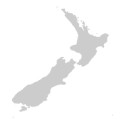Fissidens leptocladus
Müll.Hal. ex RodwayAsexual propagules absent. Mats on soil or rocks. Stems 5–20 mm long, simple or occasionally branched, central strand present, with rhizoids at shoot and branch bases. Leaves linear-lanceolate, lanceolate or oblong-ovate, ±falcate, strongly falcate-decurved or secund and often crisped when dry, 1–1.75 mm long, perchaetial leaves to 2 mm long, ±undulate; costa subpercurrent to occasionally percurrent; apex acute to narrowly acuminate. Apical and dorsal laminae with entire margins, with several marginal rows of thick-walled narrow cells forming a distinct border except at apex, sometimes at base or occasionally less extensive; cells away from margins ±isodiametric, quadrate to hexagonal, c. 5–9 μm wide, smooth. Vaginant laminae up to 1/2–2/3 leaf length, closed, with several marginal rows of thick-walled narrow cells forming a distinct border in basal half, or occasionally weak or absent. Dioicous. Seta 2.5–6 mm long, straw-coloured to orange-brown. Capsule oblong or ovate, inclined, straight; theca 0.5–1 mm long. Calyptra smooth, cucullate. Operculum obliquely rostrate from a conic base, c. 0.5 mm long. Peristome teeth bifid.
GleP, VVP, GipP, OtP, WaP, Gold, CVU, GGr, EGL, EGU, HSF, HNF, OtR, Strz, VAlp. Widespread along and south of the Great Dividing Range in a variety of wet sites including coastal cliffs, caves, rocky gorges, and waterfalls and creeks in sclerophyll forest and cool temperate rainforest. Also WA, NT, SA, QLD, NSW, ACT, Tas. New Zealand and Chile.
 Spinning
Spinning


